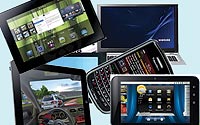DIGITAL SOLUTIONS
SECTION ONE
SECTION TWO
SECTION THREE

What Are the Most Popular
Digital Shopping Tools?
Individual digital shopping tools are continually reshaping the path-to-
purchase. Trends indicate that users are becoming more discerning
about which tools to use at specific times in the shopping cycle. In the year ahead, CPG brands should continue to invest in digital shopper marketing as a way to influence purchase decisions and extend brand messaging.
Those are key findings of CatapultRPM’s 4th annual Digital Shopper Marketing (DSM) study that examines trends around the many tools that shoppers use along their path to purchase. The study covers perceptions and behaviors regarding over 30 digital shopping tools. The robust sample of 1,412 shoppers spans grocery, mass, drug, dollar, club, specialty and convenience store shoppers. This year the study also explores the digital habits and preferences of the Hispanic shopper.
According to the study, the days of digital as a separate vehicle of communication are over. A multi-device path-to-purchase is emerging in its place. Shoppers are using one, two, even three devices to aid them along their purchasing journey. They include tablet, PC/laptop and smartphone. Interestingly, consumers will even use more than one tool when making purchases online
Whether it be at-home, in-store, or on-the-go, the study said the tools that shoppers find most helpful are rooted in their ability to save time, save money and offer a recommendation. And there is a correlation between helpfulness and tool adoption. For example, the tools that are not only helpful, but have also secured mass adoption, are handheld scanner, printed coupons from the Internet, paperless coupons sent to loyalty cards, mobile coupons and online circulars.
Collectively, the digital tool usage of Hispanic shoppers differs from the general population. For example, these shoppers over-index for smartphone ownership when compared to the rest of the country. However, to really gain an understanding of unique Hispanic shopping habits, the study looked at Hispanics according to their level of acculturation. To that point, bilingual Hispanics are the largest group of smartphone owners at 68%, while just 58% of Spanish-dominant Hispanics and 53% of English-dominant Hispanics own smartphones. Overall, the digital tools with mass adoption in the Hispanic population are self-checkout, Search, and coupons printed from the Internet.
Understanding that digital tools do not work in isolation, say the study authors, it will become critical to ensure that the promotion strategy delivers against a multi-device, multi-channel path to purchase. It is especially important to be involved in all shopping mindsets because a purchase could occur at any point. The tools should serve as “function plus.” So while they can be used for finding good prices, deals, and convenience, they can also be used for idea-generation and higher order needs. In fact, shoppers are looking for this.
In the first year of the Digital Shopper Marketing study, marketers were beginning to use DSM tools to shift from passive, one-way messaging, to a two-way, active conversation with shoppers. The DSM tools that saw the most success provided value or information and made shopping easier. DSM 2.0 illuminated how technology was making great progress in delivering against important shopper needs. In addition to the already established at-home tools, on-the-go tools started to gain momentum, especially those that were utility-based. In the third year of DSM study, several tools had achieved near universal awareness (90% or greater), and utility played an even bigger role as a key success criteria.
CatapultRPM is a behavior-based marketing services agency headquartered in Westport, Conn.
